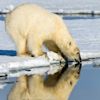
Self drive Iceland Circle touring review
Our guest, Barry Stone, spent 8 days on our Iceland Circle self-drive this year. Here is his story.
Exploring Iceland is to embrace Mother Nature’s wild side, as Barry Stone discovered on a thrilling drive on the Ring Road.
So this is how it feels to stare into the seething, churning face of nature. More than 140,000 litres of water per second, plummeting out of sight over Godafoss waterfall in north-central Iceland right in front of me. And I mean right in front, an arm’s length away from a 15-metre drop and probable drowning in the unlikely event I survived the fall. I inched my way across a patch of ground the size of a coffee table — my sanctuary — at the top of the falls, determined to dip my hand into it, determined to feel its power. I leant over the embankment, lowered my hand into the icy torrent, and exhaled as the final seconds of a wild Skjalfandafljot river cannoned into my palm.
No one clambered down from the ridge above to join me. No one dared. It was the in-your-face ‘Wild Iceland’ moment I’d always dreamt of having. Surrounded by an 8000-year-old lava field, Godafoss — the ‘Waterfall of the Gods’ — is a mammoth waterfall in a land of mammoth waterfalls, accessible from the east after a day and a half’s drive from the capital Reykjavik or from the west for the few who, like me, had already spent a week driving Route 1 — Iceland’s famous Ring Road.
Glacial extremes
I’d never seen so much diversity so tightly packed together. I walked on broad black-sand beaches, along the boundary of the North American and Eurasian tectonic plates, and across Vatnajokull glacier — at 3100 cubic kilometres larger in volume than any European glacier thanks to the Gulf Stream which delivers an abundance of moist, glacier-building air — on a four-hour rope-assisted walk with crampons along its heavily incised surface. I ate nicely marbled Icelandic beef while sitting by the still shoreline of Jokulsarlon glacier lake where blue icebergs calving into the water was the only sound my ears could hear.
Route 1 heads south-west out of Reykjavik and gets you to Jokulsarlon in about four hours. East Iceland is a land of glaciated valleys and elegant, elongated fjords and — oddly, considering their often precarious aspects — roads severely lacking in guard rails, an adrenaline-inducing oversight as I tore around promontories and across mountain flanks along some of the finest coastal roads I’ve ever driven.
One of the surprises of East Iceland was the fishing town of Faskrudsfjordur. The French had heavily fished Icelandic waters since the 16th century and street signs here were in Icelandic and French. There was a French cemetery outside town filled with too few of the many thousands of French sailors who lost their lives in 100-plus shipwrecks, and the former French hospital is now a fine hotel with an excellent museum detailing France’s long history of Icelandic miseries.
Beyond the road I spent as much time off Route 1 as on it, including a detour on the way to Krafla to the village of Borgarfjordur in the northeast where fisherman still put to sea using traditional hookfishing methods. What drew me there, however, was the avian equivalent of penguins — a colony of Atlantic Puffins! — on a very accessible headland alongside Borgarfjordur harbour.
In 1724 in northern Iceland the western flank below Krafla volcano’s 818-metre-high, 10-kilometre-wide caldera erupted, creating an ‘explosion crater’ which locals called Viti (literally, ‘Hell’), because of the so-called ‘Myvatn Fires’ that followed — lava fountains that burst skywards through fissures.
A seven-kilometre detour off Route 1 near the mudpots of Namaskard took me through a geothermal power station to Viti, where I battled a ferocious gale while on its rim that threatened to blow me into the crater, a gobsmacking sight the size of six Sydney Cricket Grounds.
Iceland, however, is as much about art as nature. Akureyri, Iceland’s ‘northern capital’ is a hotbed of 1920s and ‘30s Bauhaus architecture that had me wandering its streets until my feet ached, while the Blonduos textile museum boasts permanent wool and embroidery displays and a stunning exhibit of traditional Icelandic costumes.
In Reykjavik there are grand examples of public art courtesy of artists like Guido van Helten who, working from photographs supplied by the Reykjavik Museum of Photography, is turning the city into his own private canvas, covering commercial buildings with superb examples of realism that are nothing less than Fine Art.
Finally I immersed myself in the mineral-rich waters of the Blue Lagoon thermal spa, Iceland’s single most popular attraction, its waters rich in silica, sulphur and blue-green algae. About 600,000 people a year bathe here, another reason why tourism trumped fishing as Iceland’s primary industry in 2014, a statistic I’ll be adding to when I return to bounce along the country’s remote interior roads next year. So much ice; so little time.
Our guest, Barry Stone, spent 8 days on our Iceland Self drive tour this year.
